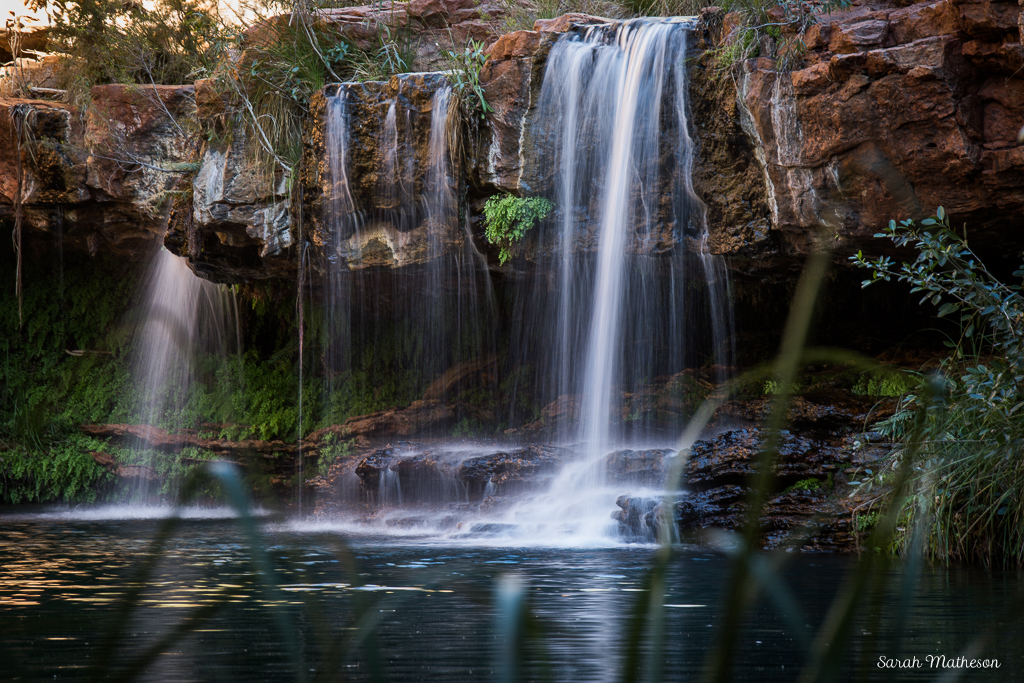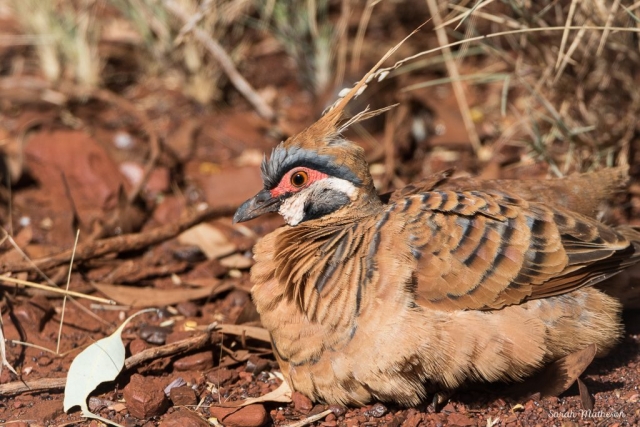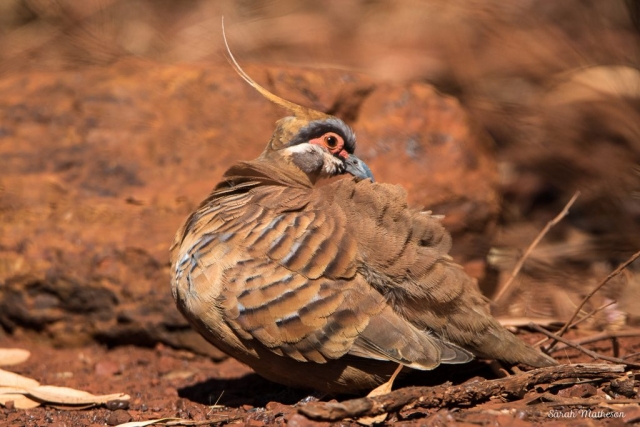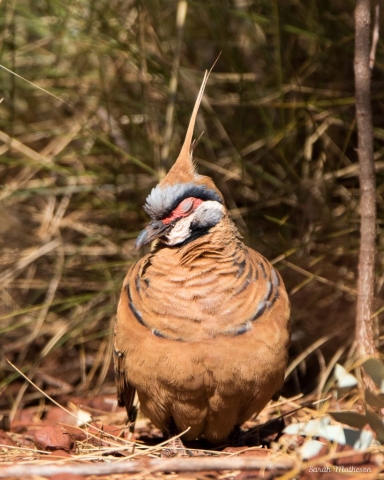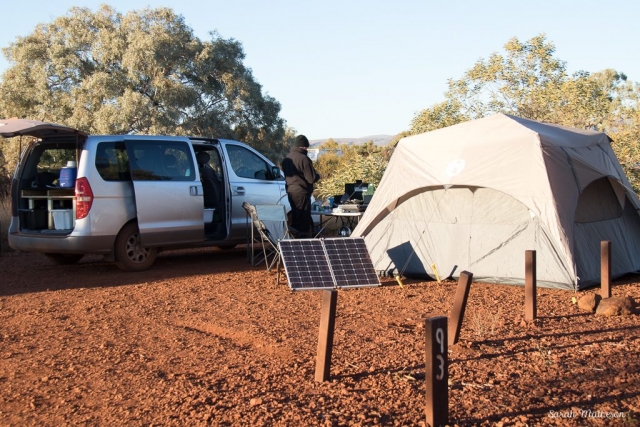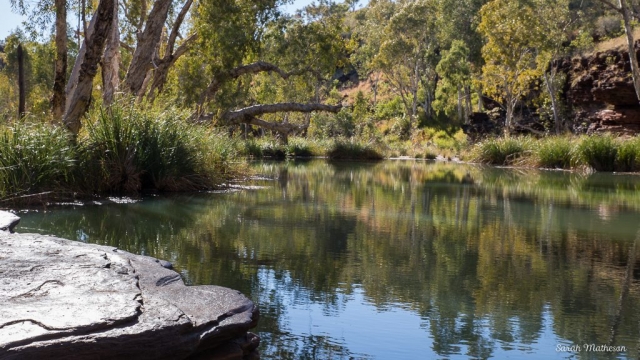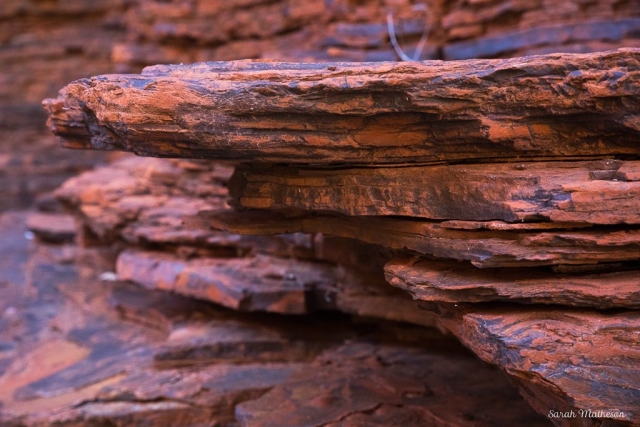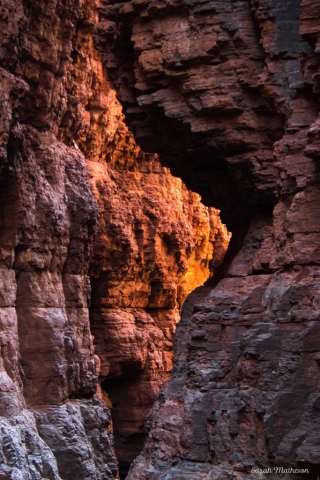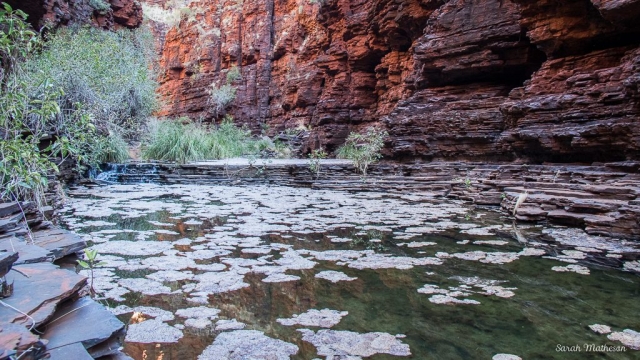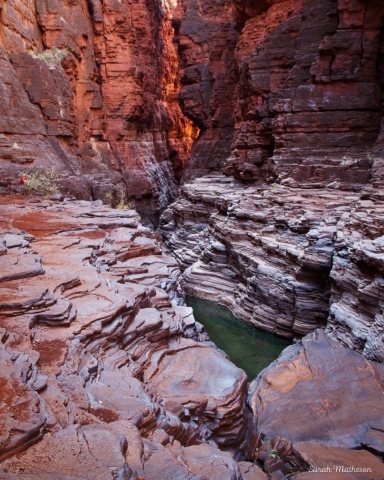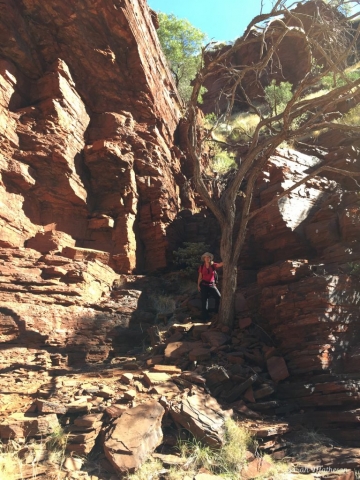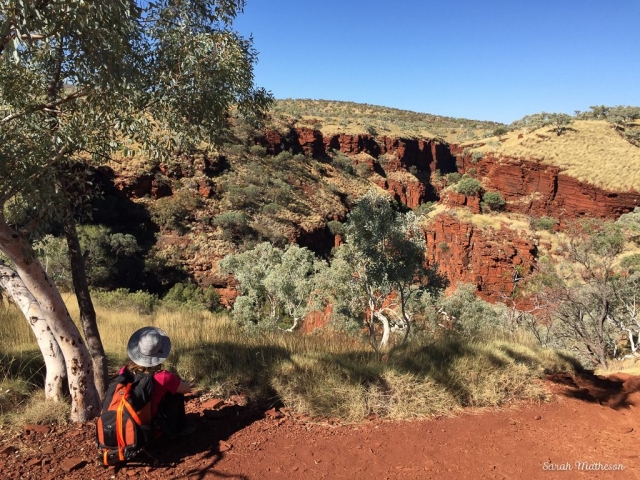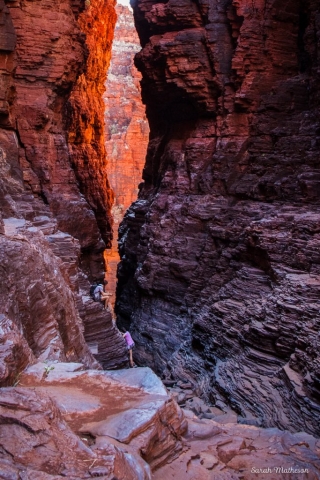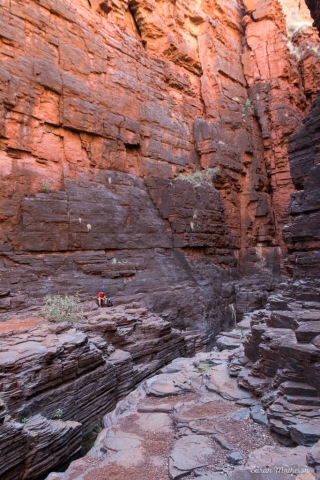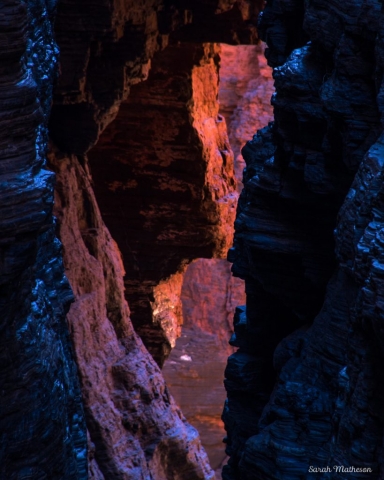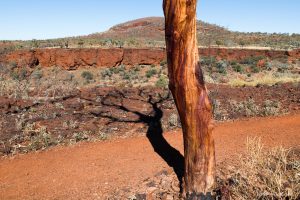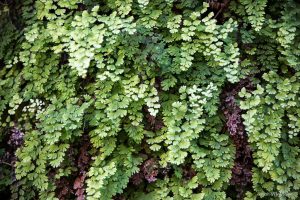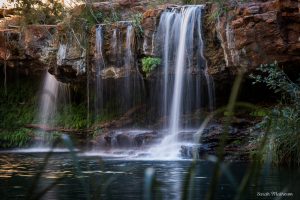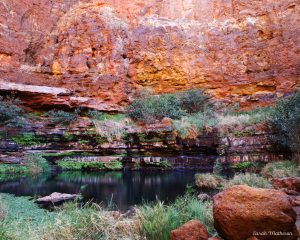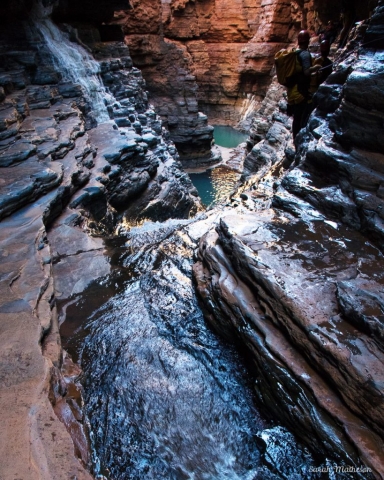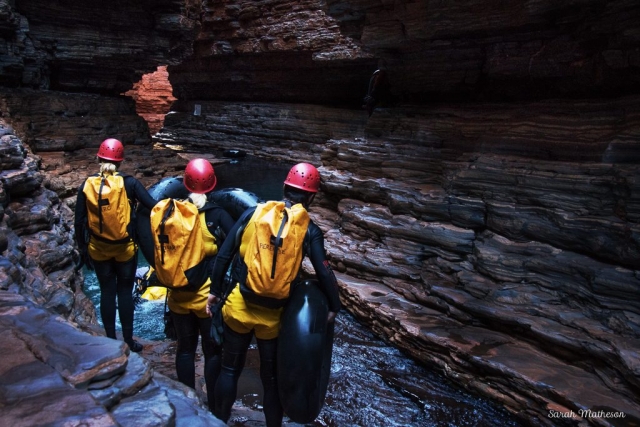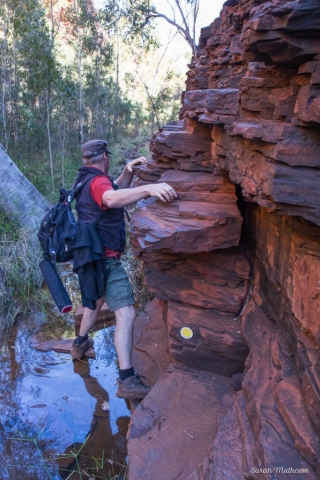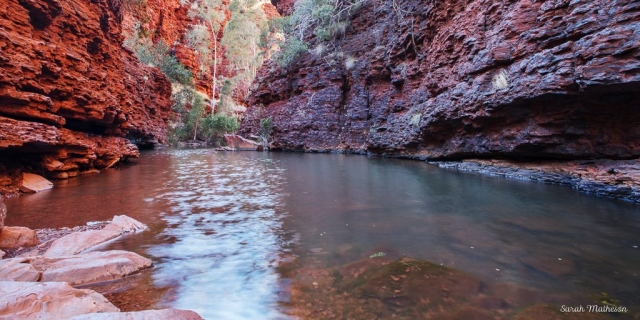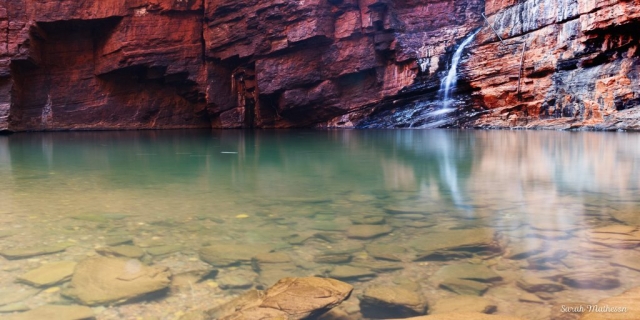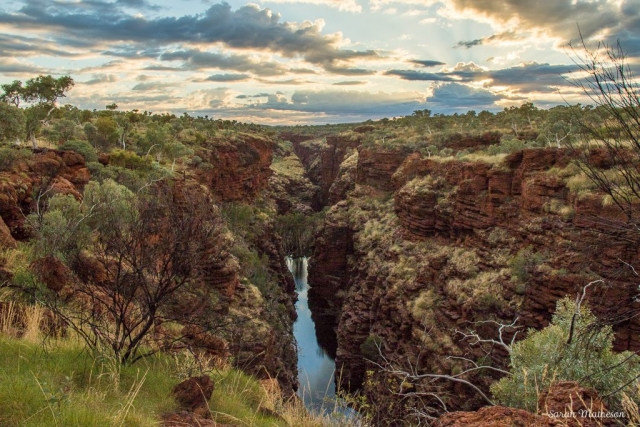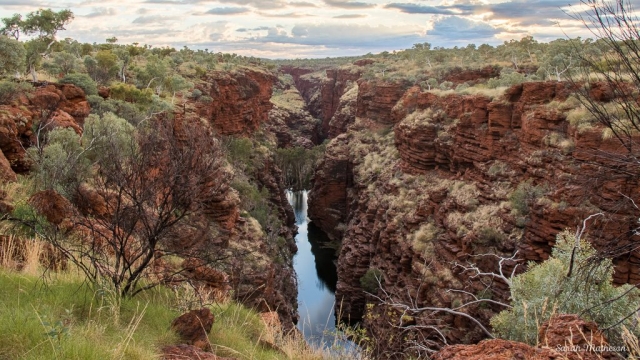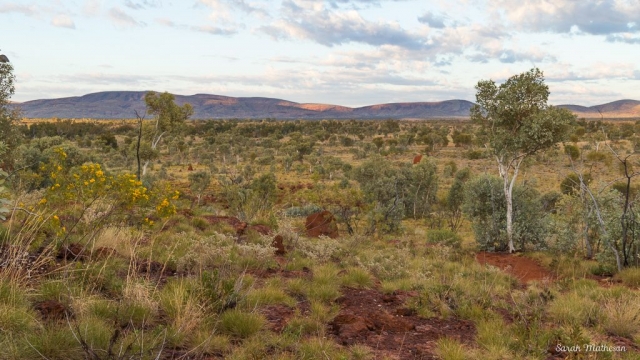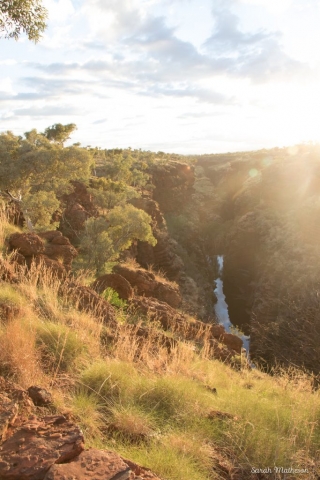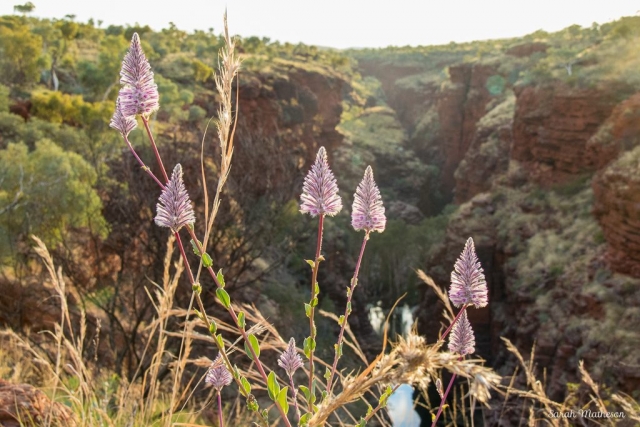Pilbara 2017

I’ve lived in Western Australia practically all my life, but in this big old state of ours there are still so many firsts for me. We’ve just returned from a trip ‘up north’ to Karajini National Park in our new-to-us Hyundai iMax van (henceforth known as Coops*).
You may recall we had a fabulous camping holiday last year courtesy of Tears of Joy. Our holiday plans for this year originally involved setting off in a teardrop camper of our very own, but things haven’t panned out that way. Necessity being the mother of invention K spent the week before this trip decking Coops out to accommodate gear, and add a backup sleeping module in case our borrowed tent didn’t work out, (or the more likely scenario that one of us started snoring too loud – him not me BTW).
Loaded up with a significant amount of borrowed gear including a partially deflating blow-up mattress, a Waeco fridge, solar array and deep cycle battery, the afore mentioned tent, and a range of different tent pegs, we decided to go up by road – about a 16 hour drive. There weren’t a huge number of things we wanted to see on the way up, it was June and the wildflowers aren’t quite out yet, so we did it in two eight hour driving days.
You may want to grab a cuppa - this is going to be a long one. Don't complain later - you have been warned
Our half wayish stop off point was an active cattle station just north of Cue called Nallan Station. It offers basic unpowered camp sites, toilet and shower block for $20 a night. There is a self registration station as you arrived (make sure you have the right change on you not like us newbies) where you write down the site you’ve picked, how long you are staying and pop your money in. The guys in the ute come round as the light starts falling to check the box and see that all is well.
The most notable thing about our stay was the night sky. I’m kicking myself that I didn’t get a picture – the moon was on the wax, and while the skies we saw thereafter were pretty, they had nothing on that first night. The isolation and lack of light pollution lit the milky way up like Broadway. It brings a smile to my face just thinking about it now. I will certainly drive 8 hours to go back and see it again. And take a picture or two next time. Lesson learned #1.
Day two took us further on up Great Northern Highway, through Meekatharra and Newman, past countless Big Holes in the Ground and into Karijini. K did all of the driving, though I did offer more than once, and negotiated the passing of road-trains beautifully. They were all very polite, signally to indicate when it was safe to pass. We also had a David Attenborough memoir on audio book which helped pass the time. More on that in later post as I have some deep and abiding thoughts about it. Well, you know me, right?
I was amazed and delighted by how many pairs of Wedge tailed eagles we saw on the drive. They were commonly perched in dead trees, or circling the skies. Magnificent birds. Had we been taking a more leisurely approach to the drive I would have like to stop and watch them for a while but not this trip. We also passed a depressing number of dead kangaroos road side, and one very smashed up car on one side of the road and one very dead bull on the other. I’d be suprised if the driver came out of that well, and it was s stark reminder of how careful you need to be behind the wheel, and how critical it is to drive to the conditions and avoid night, dawn and dusk.
We arrived in Karijini around 3 pm and started by popping in to the Visitor Centre. We picked up a couple of maps of trails and walks around the park, and I noted the adventure tour and suggested that we try that out one day. K wasn’t convinced and just said we’d see how we went.
There is an unsealed road between the visitor centre and our camping ground, Savannah, at the west side of the park. We decided to take our chances and take the 33km short cut. Possibly not out wisest decision, but we made it through without any permanent damage or a major argument. There were some patches of corrugation when we though the van might shake apart though, so we determined that we would travel round the long way next time.
Of course, we ended up having to come back along that road, part way at least, to visit some of the gorges, but that just allowed us to give Coops a nice dusting of red dirt. To prove we’d been away. And to give K something to clean when we got back, cos he likes that 🙂
We were booked into the Savannah campsite, part of the Karijini Eco Retreat. I would have liked to spend some of our time at the east side too, Dale’s, but you can’t book a spot there, and it was likely to be busy. I didn’t want to chance driving 16 hours to find out there wasn’t a place for us, so Savannah it was to be. If we head back we will go at a quieter time and spend time at both sites.
Savannah is nice enough, without actually being charming. It feels like a caravan park without the grass really. There are toilets, showers, a camp kitchen and water. Ice is available from the resort, which also offers glamping options, and a restaurant and bar. Our first big challenge, and when I saw ‘our’ I really mean K, was to get the tent pegs into the rock hard, compacted ground of the camp site. We have borrowed a few heavy duty pegs, but could have done with a whole heaps more of those. Without the heavy duty mallet to go with them I suspect we would have been in a spot of bother. And well secured tent pegs were a must as we had some very blowy nights. In the middle of one the awning was blown down, but the tent and we were fine.
Unlike Nallan station there was no sense of isolation at the camp site. You are most certainly at a tourist destination. I found this in contrast to how I found traveling the Gibb River Road. The camp sites we used on those trips had a much more relaxed feel. They felt like place you’d go to, to stay in, even if there wasn’t a stunning gorge not far away. Savannah campsite was a place to sleep, eat and shower. Oh and to hang out with the cutest pigeons under the sun.
These are Spinifex Pigeons. Check out the mohawk. Not only are they very pretty to look at, they are charming to watch. Every morning they would systematically work their way around the entire camp, checking out those recently vacated sites with careful attention, like they were the caretakers come clean-up crew. They would have made great birds with arms – I should have taken some video darn it. They hang our in little gangs of three or more, I never saw one on its own.
If you sat down for a while it wasn’t unusual to have one scuttle about under your chair, or fossick around next to your foot. Apart from a few geckos, a flock of flying foxes and crowds of zebra finch, we didn’t see a whole lot of wildlife during our stay. We did see a blonde streak that may or may not have been a dingo but we can’t be certain.Day three we were all set to start seeing some of the famous Karijini Gorges.
There are 6 main gorges that are accessible to the public is varying degrees.
The gorge referred to as ‘most accessible’ is Kalamina Gorge. By most accessible I think they mean once you get there, as it requires you to drive down the unsealed road between the Visitor Centre and Eco Retreat. Once there, there is a bit of a climb down into the gorge and you are met by a lovely (cold) pool and a waterfall. From here you can trek on for about 3km enjoying the scenery. We got there at about 10:30 am, so everything was lit up like a sunny winters day. Landscape photographers are a dedicated bunch who get up at the crack of dawn and stay out until the sun goes down. I’ve never claimed to be one of those magnificent types. Maybe one day I’ll find some greater dedication. I did try to keep Rob’s mantra of Foreground, Middleground, Background in mind though. I may have been mumbling it enough to get some strange looks from tourists merrily taking pictures on their phones and moving on. I do not claim I got better pictures than they did, but I will learn from them damn it!
The Geos out there would have more to say than I on the amazing rock formations and their makeup. To me there are very beautiful. On the up side, I did take some time to play around with my new Syrp Variable Neutral Density Filter. I still have a lot to learn, but it was cool to get some results.
Close-ish to Kalamina Gorge is Knox Gorge and Lookout. This was one of my favourites, and also where I came a cropper.
When you’re looking down from the Knox Lookout you can see these people clambering around in ways that looks exceedingly hazardous. And there are certainly some spots that are – Karijini is not a safe place – people die here. However, the bits that looks heart stopping from above are quite commonly a fairly easy walk once you’re down there. All walks are graded, with most being Grade 4 or 5, and the directional markers are surprisingly good when you think about the movement that happens during the wet seasons.
While the rocks can be slippery when wet, when dry they are firm and often have good handholds. There is always the risk of rock fall from above – nothing you can do to avoid that except to look at other peoples pictures from the comfort of your own home. You can, of course, avoid doing stupid things, and it pays to pay attention to every step you take. Lessons Learned #2.
My slip-up happened as we were heading back along a relatively tame path, and needed to cross over the running water. It was shallow, not fast flowing, and there were stepping stones and patches of earth to support the crossing. K was ahead of me, and having ever so slightly longer legs than I, had chosen a stepping stone well within his reach. As I was mid step I thought to myself, that rock is a little bit far away, and then found myself fighting for balance before sliding sideways and landing in the water.
My first though, naturally enough for some of you I suspect, was to get my backpack off and hand it out of harms way to K. I had forgotten that I had my Spider Pro holster on and my camera was actually on my hip. Fortunately I had slipped to my left, and my camera was on my right hip not in my backpack. Convenience always has a price. It got a little splashed, but the 7D mark II is pretty hardy with its weather sealing and I’m happy to report that no permanent damage was done to it or to me. I did have a corker of a bruise on my knee, which was a reminder to never be complacent, and to watch each and every step with care. My boots got a good dunking in the water and my socks were drenched. My trail pants were dry by the time we got back to the van, but my boots were out of action until the next day.
All in all things could have been significantly worse. The next day, while trailing behind the Adventure Tour we heard the tour guide explain that the average rescue time is 16 1/2 hours…
In future I will beware hazardous river crossing of this ilk. (NB – this was the mildest, weakest, crossing of a puddle you can imagine and this was entirely user error)
Knox Gorge is most definitely worth the scramble down and the inevitable climb back up.
Dale’s Gorge was the most relaxing walk of the set for us. We went from Fern Pool, along the gorge, returning by the walk at the top. As a general rule of thumb the walks took us around about as long as the walk guides suggested – but that included me stopping to set up and take shots along the way. If you were just walking, and had the same level of fitness and agility as we 40 somethings, you could do all of them in about 2/3 the time if not half.
As previously mentioned, I would have liked to stay at Dale’s campground, allowing me to get to Fern Pool, and other spots, before the sun got down in there. That’s going to be another next time thing. To get there we parked at the Fortescue Falls car park and went down countless steps. Technically, if you are that way inclined, and I know some of you are, you could count them. I had better things to do, like look at the scenery, and my feet simultaneously. A radio national interview I heard the other day talked about the challenges of doing using different parts of the brain at the same time. I didn’t count the steps, and I lived to tell. Let’s move on shall we?
Fern Pool is a quiet, sacred spot, worthy of some peaceful contemplation. I was using the ND filter here to get that soft water flow, but you’ll see that big bright spot at the top left that tells you I got there too late. Straight into the Lessons Learned folder #3.
Although not it’s original name – given the close Aboriginal involvement in the running of the park I might have expected the traditional names to be alongside their superimposed ones on the maps we picked up – Fern Pool is descriptive. In the middle of this flat, arid landscape these gorges have retained the lush vegetation of a more fluid past. No more so than in Fern Pool.
There are signs throughout the park advising of the presence of naturally occurring asbestos. In its undisturbed and not mined-to-buggery or processed state it is relatively low risk, but it is one to be aware of. Don’t go scratching about in blue looking rock. I wish I’d had one of my rockologists with me.
At the end of Dale’s Gorge is the lovely and again aptly named Circular Pool. This more than any other reminded me of some of the swimming holes we visited in the Kimberly. We had the good luck to have it pretty much to ourselves for about ten minutes which was nice. Another point about going early. Which reminds me of advice I read once about the black plague. Go Early, Go Far, Stay Long. I think there is a life lesson in that actually. And no, I am not old enough to remember the plague personally. Thanks for asking. I know who you are.
After a peaceful interlude we hiked our way back out of the gorge. This time the steps were, well, more rustic… We met a lovely retired couple on their way down. They are who I want to be in twenty years.
The walk along the top is easy going, but gives you a lovely view of Mount Bruce and the Bloodwood trees. The way the flat ground descends into these gorges so rapidly never fails to remind me of Drumheller in Canada. If you haven’t been, add the museum to your bucket list. Quite amazing.
We are working our way up the Class 5 walks – the more dramatic and tricky of the bunch
Hancock Gorge was where we ran into the Adventure Tour Group. Almost literally as we came down the ladder. I should say at this point that K’s call to ‘see how we went’ in regards to taking this tour was, as usual, a bloody good idea. The group was all decked out in suits, wet or dry I can’t be sure, hard hats and inflated inner tubes.
We managed to follow the group along, in the pretense of giving them right of way, which meant we could see you the experienced guide managed to negotiate the tricky maneuvers. Remembering them for the way back is another story of course. We also got the low down on how to stand like a pencil and yell ‘rock, rock, rock’ in case of, well, rocks falling from above. It should be noted that they had hard hats on, but I think I would still go with that approach. In the amphitheater we were told about the last unfortunate soul who decided that a cool selfie was worth standing on a rock overhang – Just Don’t.
Getting in to Kermit’s Pool beyond is via the Spider Walk. Sadly the names, and videos have lead to a lot of people trying to be clever clogs and consequently damaging ankles and other important parts of the skeletal system. 16 and half hours average rescue time folks. Much better to just be careful, get your feet wet and take your time.
And then we saw them disappear , very slowly as it happens as they had to abseil down one at a time, into the part of the gorge that is not accessible to the unwashed masses. And at that point I thanked my lucky stars for my skeptical husband. There was no way I would have gone down there.
We are still in discussion about how Weano Gorge is meant to be pronounced, but that was the next on our list.
We’d actually started with Weano Gorge on our first day, but we weren’t brave enough to get our kit off to wade into Handrail pool. People around us were happily shedding the clothes and starting to wade off into the near freezing water, but we had a few days up our sleeves and thought we’d take our time. In one of these pictures you can note;
- Yellow dot indicating the trail grade and path
- K navigating a bend while trying to keep his boots dry
- K being a superstar and carrying my tripod case for me
When climbing down from the carpark you can turn right and head to Handrail Pool, or do as we initially did and head left to see the rest. All of it is pretty, but be sure to try to get to Handrail Pool before the hoards descend. Only an ND filter, a long exposure and a bit of luck enabled me to grab a shot before the place was filled with about forty tourists. Yes, I know I’m one too, but I don’t tend to be the screechy kind, Just saying. If you look carefully you will see the handrail for which the pool is named.
On our way back out, escaping the madding crowds that consisted of a backpacking tour of early twenty something, we came across a group with a mishap. One young lass had taken a tumble and a hard hit to the head. Luckily someone coming the other way had a medical background and could help them through basic checks, and she was still mobile, though shocked and with a very sore head. Watch your step is the Karijini mantra me thinks.
Which leaves us with Joffre Falls. I thought that Joffre was a made up name for Game of Thrones, but the joke is clearly on me. The other joke was that we drove around via the unsealed road, only to discover we could easily walk there from our camp site. As is often the case, those things that are closet to us are the most ignored, and I didn’t end up climbing down into the falls. I did spend some time ‘up top’ which was lovely. The hoards of fellow togs who came flittering through the bush at twilight left me feeling decidedly self conscious, but I figure in thirty years or so I’ll get over feeling inadequate.
The last of the gorges, and the furthest afield, is Hamersley Gorge. It is home to the spa pool, a beautiful photo of which by Dylan Fox has been shortlisted in the ANZANG Nature Photographer of the Year awards this year. I had read on a coupe of trip advisor posts that part of the walks had been closed shortly before we were due to arrive, and getting there meant a 100 km round trip on unsealed roads, so we opted to do this one ‘next time’.
I was intending to do this whole trip in one hit, but on the way home we visited Woormael Station, and it deserves a space of its own, plus I’m getting tired of this post even if you aren’t. So, until next time, get out there and enjoy this amazing planet that we are lucky to have.
Summary:
Would I go again?
Yes – in a heart beat. hopefully with our little camper. Winter is lovely, and I think I would aim for that again, or spring as I suspect summer and flies would be a bit wearing. We shall see.
What would you do differently?
Totally avoid school holidays. We only had a couple of days crossover, but the stampede of little dusty elephants using our campsite as a racecourse wasn’t really our speed. That said, the hipster types there on our first night who decided that the bush is the best place to turn their musics up loud weren’t really to my taste either so maybe I’m too particular.
I would make sure I spent time in both camp sites. I would get up earlier, stay out later, bring a 4wd for those unsealed roads and make sure I was going to be there not at full moon so I could get some starry skies.
Footnotes
*Coops because we anticipate friends and family and friends of friends and family may, on hearing we have a van, ask to borrow said van to shit the occasional thing, to which K’s answer will be sure, for a case of Coopers Green. Or so the story goes.
© Sarah Matheson all rights reserved
